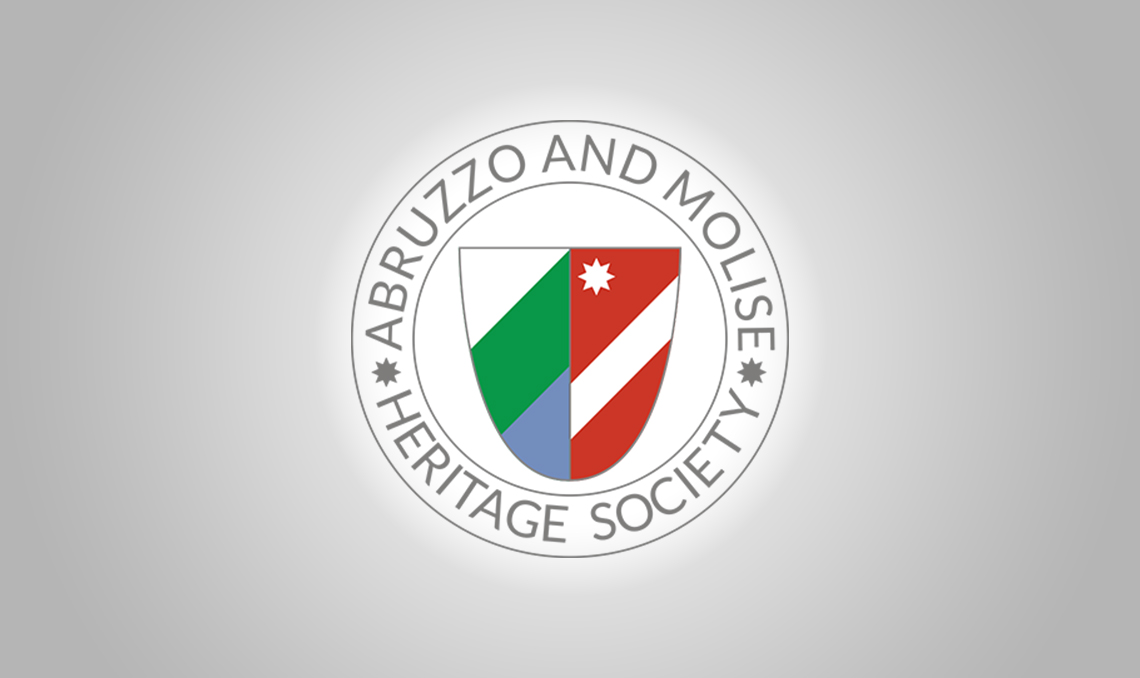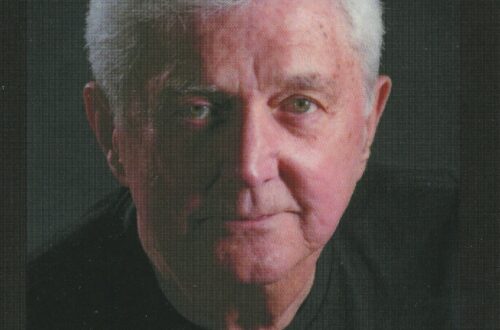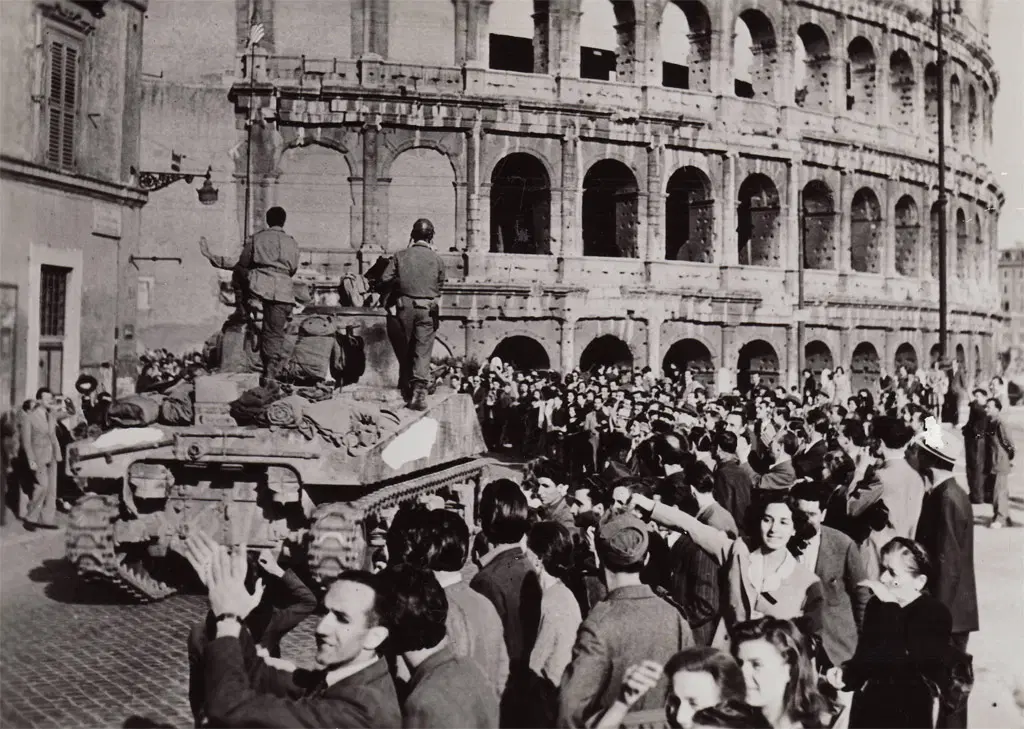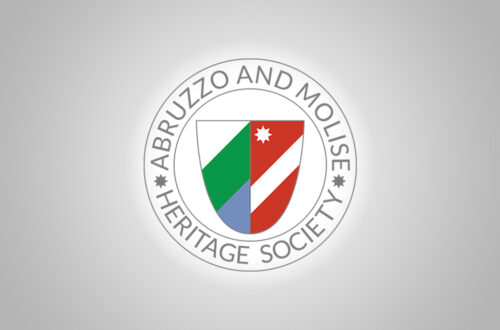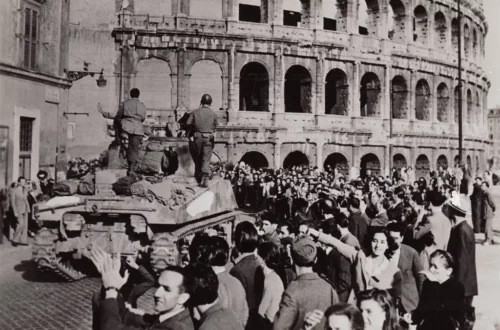-
Proposed Changes to AMHS Bylaws to be Voted On at September General Meeting
On March 23, 2024, President Chris Renneker, Immediate Past President Ray Laverghetta, and Secretary Joseph “Sonny” Scafetta, Jr. met in Washington, D.C., and developed the proposed bylaw amendments (reprinted below with comments on the proposed changes) which were unanimously approved by the Executive Council during its meeting on May 13, 2024. Therefore, the EC strongly recommends that the general members vote to adopt them at the next meeting on September 22, 2024. As required by the current bylaws, at least 30 days notice is being given before the vote. A quorum of 15% of the general members is necessary for the bylaw amendments to be adopted.
Respectfully submitted,
Joseph Scafetta, Jr.
AMHS SecretaryBY-LAWS OF THE GRANT AND SCHOLARSHIP FUND, INC. OF THE ABRUZZO AND MOLISE HERITAGE SOCIETY OF THE WASHINGTON, DC AREA dba as THE ABRUZZO AND MOLISE HERITAGE SOCIETY OF THE WASHINGTON, DC AREA
NOTE: Deleted language is struck through; added language is italicized.
ARTICLE I – Objectives
The objectives of the Grant and Scholarship Fund, Inc. of the Abruzzo and Molise Heritage Society of the Washington, DC Area dba as The Abruzzo and Molise Heritage Society of the Washington, DC Area (“Society”), are to promote the cultural, social, and educational heritage of the Italian regions of Abruzzo and Molise and of Italy in general. The Society also endeavors to increase the awareness of the contributions in the fields of the arts and sciences made by Italians and Italian Americans, especially those having roots in the regions of Abruzzo and Molise.
Comment: No changes.
ARTICLE II – Membership
Section 1: Eligibility
Membership in the Society shall be open to natives of the two regions, their descendants, anyone who is a friend of the regions, and anyone who is interested in and supports the Society’s stated objectives.Comment: No changes.
Section 2: Classes of Membership
There arefour (4)five (5) classes of membership: General (Couple and Single), Associate, Student, and Honorary, and Guest. It shall be the responsibility of theSecondVice President,serving as Membership Committee Chair under Article VII, Section 3,to review membership applications in accordance with the criteria for each class of membership.All classes of membership must be current in annual dues.Comment: A fifth class of Guest membership, to be described below, is created for which no dues are payable. Underlined words are added. Stricken out words are deleted.
a. General Member: a member who has joined as a General Member (couple or single). He/she may hold office, vote, and participate in all activities sponsored by the Society and has all the privileges of full membership of the Society.Comment: No changes.
b. Associate Member: a member who resides outside a fifty (50) mile radius from Washington, DC. An Associate Member has all the privileges of a General Member except for holding office and holding committee chairmanships. An Associate Member shall be entitled to reduced membership dues, as determined by the Executive Committee. An Associate member may apply for General membership.Comment: Change makes it clear that reduced dues for Associate Members are determined by the Executive Committee.
c. Student Member: a member who is enrolled as a full-time student in a school or institution of higher education. A Student Member has all the privileges of General membership, except for holding office. He/she shall be entitled to reduced membership dues, as determined by the Executive Committee.Comment: First change allows Student Members to hold office. Second change makes it clear that reduced dues for Student Members are determined by the Executive Committee.
d. Honorary Member: a person who has made an outstanding contribution to promote the objectives of the Society. This designation shall be conferred by majority vote of the Executive Committee. An Honorary Member is not subject to membership dues, but shall be granted all privileges of General membership, except for voting and holding office. An Honorary Member may apply for General membership.Comment: No changes.
e. Guest Member: a person who has made an outstanding contribution to promote the objectives of the Society. This designation shall be conferred by majority vote of the Executive Committee. A Guest Member shall be entitled to one year of free membership dues. A Guest Member has all the privileges of General membership, except for voting and holding office. A Guest Member may apply for General membership.Comment: This subsection adds a new category of membership.
ARTICLE III – Dues
The Executive Committee shall have the authority to change the annual dues. The annual membership period is for one calendar year from when a member joins the Society. Annual dues must be paid no later than thirty (30) days after receipt of an invoice for current dues. Any member whose dues are unpaid thirty (30) days after the expiration date shall receive a delinquency notice from theMembership CommitteeVice President. If payment of the dues or a letter of explanation has not been received by theMembership CommitteeVice President within thirty (30) days of the mailing of the delinquency notice, the membership of the delinquent member shall be terminated effective on the date of notification.Comment: Responsibility for dues is shifted from the Membership Committee to the Vice President.
ARTICLE IV – Expulsion/Resignation/
ExpulsionThe Executive Committee, for good cause and upon proper investigation and review, mayrequestexpel a memberto resign.Any annual dues paid shall be prorated and refunded. The person shall then cease to be a member.A member resigning from the Executive Committee must give thirty (30) days notice to the President.Comment: The Executive Committee may now expel a member, instead of being limited to merely asking for the resignation of the member who may refuse to resign. Also, whenever a member resigns from the Executive Committee, he/she must give 30 days notice to the President. Under the current Article, nothing was stated about resignations.
ARTICLE V – Officers
The officers of the Society shall consist of the President,FirstVice President,Second Vice President,Secretary, and Treasurer. Besides the officers, the Executive Committee shall compriseandthe Board of Directors, which includesnine (9)six (6) electedboardmembers, plus two (2) ex-officio members (the President Emeritus and the Immediate Past President). The term of office, except for the Boardmembersof Directors, shall be for a period of two years.Officers, except for Board members, may hold the same office for no more than two consecutive terms.Terms of office for the Boardmembersof Directors are described in Article VII, Section65. Any officer of the Society who is absent from threeor moreconsecutive Executive Committee meetings, without just cause, will be considered inactive in his/her post, and may be asked to resign his/her position. Whether an absence is without just cause will be determined by a majority vote of the Executive Committee members present at the meeting.Comment: The positions of the Second Vice President and three Directors are abolished, to be effective September 22, 2024. Also, the limit of two consecutive terms for officers is abolished and the determination of an absence without just cause is decided by a majority vote of the Executive Committee present.
ARTICLE VI – Election of Officers & Directors
Section 1: Nominating Committee
In June of each election year, the President shall appoint a Nominating Committeeof at least three (3) membersto recommend a slate of candidates for positions of officers and directors for the ensuing terms of office. The Nominating Committee shall consist of Society members who have been in good standing for at least two (2) years.Comment: The addition of “and directors” makes it clear that the directors are not officers. Also, the requirement that the Nominating Committee must have at least three members is eliminated.
Section 2: Notice of Elections
Notice of elections shall be given, in writing,electronically to all membersin good standing,together with the slate of candidates recommended by the Nominating Committee, at the beginning of November but no later thantwo (2) weeksthirty (30) days beforeelectionsthe final date for submitting votes. All candidates must agree to serve.Comment: Notice of elections is changed from “in writing” to “electronically” and must be given “at the beginning of November” All members, not just those in good standing, are to be notified. Notice is extended from two weeks to “thirty (30) days before the final date for submitting votes.”
Section 3: Elections
Elections of officers and directors shall take placeduringthe general membership meeting of the Societyin the month of November.Additional nominations for office may be made in writing to the Nominating Committee, prior to the meeting, or from the floor during the meeting, after which the nominations will be closed and elections will be conducted by secret ballot.Members must submit their votes electronically to the Nominating Committee within thirty (30) days after receiving the notice of elections. Members may vote for other members not proposed by the Nominating Committee, contingent upon the consent of the other members. The Nominating Committee shall be responsible for counting the votes. The candidate for each office receiving the most votes shall be declared elected to that office for the ensuing term.However, if there are no additional candidates announced during the general membership meeting, the prospective candidates may be voted in by acclamation.The elected candidates shall assume office on the following January 1st and be installed at theJanuaryfirst general membership meeting of each year.Comment: The requirement that elections take place during the general membership meeting in November is eliminated. Instead, elections will be held electronically during November. Members must submit their votes within thirty (30) days after receiving notice of the elections. Members may vote for other members not proposed by the Nominating Committee, as long as the other members consent. Responsibility for counting the votes is given to the Nominating Committee. The elected candidates will be installed at the first general membership meeting of each year, instead of specifically in January, in case the first meeting takes place later than January.
ARTICLE VII – Duties of Officers & Directors
Section 1: President
The President shall preside over the general membership and Executive Committee meetings of the Society. Although the President presides at these meetings, he/she votes only to break ties. The President shall enforce the by-laws of the Society and ensure that the Society is pursuing appropriate programs and activities consistent with its objectives. The President shall establish any committee he/she deems appropriate, and appoint itschairman,chairperson.except for the chairmen of the Programs and Membership Committees which will be chaired, respectively, by the First and Second Vice Presidents.The President has the privilege to be a non-voting member of any committee of the Society. The President will be the principal delegate to any committee or organization with which the Society is affiliated, or he/she may appoint a representative in his/her place. In the event an elected office becomes vacant, the President may appoint a qualified member as a replacement to serve the remaining term of that office.Comment: The second sentence makes it clear that, as the presiding officer, the President votes only to break ties. The deletion allows the President to appoint the chairpersons of the Programs and Membership Committees.
Section 2:
FirstVice President
TheFirstVice President shall perform such duties as the President shall direct. He/she will become Acting President in the absence of the President for any reason. In case of the resignation or death of the President, theFirstVice President shall become President for the President’s remaining term of office; in the event theFirstVice President is unable or unwilling to assume the presidency, the Immediate PastSecond VicePresident shall fill the unexpired term.The First Vice President shall also assume the role of Programs Committee chairman, responsible for implementing the functions of the Programs Committee as described in Article IX, Section 1 of these by-laws.
Comment: The First Vice President will become the sole Vice President. If the Vice President is unable or unwilling to assume the presidency, the Immediate Past President returns to the presidency. The deletion allows the President to appoint the chairperson of the Programs Committee.Section 3: Second Vice President
The Second Vice President shall perform such duties as the President may direct. He/she shall exercise the powers of the President in the absence of the President and First Vice President. The Second Vice President shall also assume the role of Membership Committee chairman, responsible for implementing the functions of the Membership Committee as described in Article IX, Section 2 of these by-laws.Comment: The position of the Second Vice President is abolished. Also, this deletion allows the President to appoint the chairperson of the Membership Committee.
Section
Four3: Secretary
The Secretary shall record the minutes of any official action taken at general membership meetings, Executive Committee meetings, and other meetings as directed by the President. He/she, in cooperation with the Publications & Publicity Committee,will prepare and send out notices of such meetings. The minutes of the Executive Committee meetings shall be available for inspectionby the general membershipat the request of a member. He/she shall coordinate, review, and prepare responses to any general correspondence of the Society.The Secretary shall also maintain the Society’s legal documents.Comment: The Secretary will become solely responsible for preparing and sending out notices of meetings without the need to coordinate with any committee. Also, the Secretary will no longer be required to maintain the Society’s legal documents which are only the current signed by-laws.
Section
54: Treasurer
The Treasurer shall receive all the Society’s incoming funds and deposit the same in the Society’s accounts; provide necessary signatures for outgoing disbursements from said accounts; and maintain all financial records of the Society. The Treasurer shall report at Executive Committee meetings on the expenses incurred and the revenues received during the preceding reporting period. At the end of each fiscal year, the Treasurer shall present the financial records to theBudget and FinanceExecutive Committee for review and/or audit. The Treasurer shall also prepare and submit any forms or documents required by the Internal Revenue Service, or for any other official fiscal purposes. The Treasurer shall also maintain the Society’s legal documents.Comment: At the end of each fiscal year, the Treasurer shall present the financial records to the Executive Committee, instead of just to the Budget & Finance Committee. Also, the Treasurer will now maintain the Society’s legal documents which are only the current signed by-laws.
Section
65: Board of Directors
a. The Board of Directors shares the responsibility of managing the Society and its resources, and providing overall guidance and advice by virtue of its seat on the Executive Committee.
Comment: No changes.b. The Board of Directors shall consist ofnine (9)six (6) members whohave beenare in good standingfor at least two years. The Board shall be divided into three (3) groups ofthreetwo (2) members serving staggered terms. Each group shall be elected for three (3) yearsand thereafter have three, two and one remaining years of office. The group serving its last year in office shall retire at the end of the year. Each year a new group ofthreetwo (2) shall be elected for a three-year term to replace the retiring Directors. No electedBoard memberDirector mayserve consecutive terms orserve simultaneously in anyotherofficer position of the Society.Comment: The number of members on the Board of Directors is reduced from nine to six because of the difficulty of recruiting three new ones every year. Also, the requirement that a member must be in good standing for at least two years is eliminated so that persons who are members for less than two years may be elected to serve on the Board. Furthermore, the prohibition against Directors serving consecutive terms is removed.
c. In addition to the afore-mentioned nine (9) elected Directors, the President Emeritus and the Immediate Past President serve as additional members of the Board.Comment: This subsection is deleted to remove the President Emeritus and the Immediate Past President as Directors. However, they remain members of the Executive Committee.
ARTICLE VIII – Committees
Section 1: Executive Committee
The Executive Committee shall consist of the officers, the Board of Directors, the President Emeritus, and the Immediate Past President of the Society. Officers include the President,First and SecondVice President, Secretary, and Treasurer, and the Board of Directors. The President shall be thechairmanchairperson of the Executive Committee. The President, at his or her discretion, may invite any member of the Society to any Executive Committee meeting as a non-voting participant. The Executive Committee shall have the responsibility of management of the Society and its resources. It shall plan and schedule Society activities and coordinate the same with standing committees and other entities of the Society, as needed. The Executive Committee shall meet at leastsix (6) times aquarterly each year.Seven (7) voting membersA majority of the Executive Committee shall constitute a quorum for the transaction of business. The minutes of all meetings of the Executive Committee shall be taken by the Secretary and made available at the following Executive Committee meeting.Comment: The added language in lines 1 and 2 makes it clear that the Executive Committee includes, in addition to the officers, the Board of Directors, the President Emeritus, and the Immediate Past President. The deletions made in lines 2 and 3 make it clear that there will be just four officers: President, Vice President, Secretary, and Treasurer. The first change in line 9 reduces the number of required yearly Executive Committee meetings from six to four. The second change in line 9 revises the number of Executive Committee members needed for a quorum from seven (7) to a majority.
Section 2: Standing Committees
a. The President of the Society shall appoint theChairmenChairpersons of Standing Committees, except for the chairmen of the programs and Membership committees which are chaired by the First and Second Vice-President, respectively.Comment: The deleted language leaves it clear that the President appoints the Chairpersons of all Standing Committees.
b. The Standing Committees are:
- Programs & Hospitality
- Membership, Scholarship, Fundraising, Budget, & Finance
Budget & FinanceHospitalityScholarshipFundraising- 3. Publications, & Publicity, Web Site, & Social Media
Web Site & Social Media
Comment: The current eight (8) Standing Committees are combined into just three (3) Standing Committees performing the same functions.
c. The President mayalsoestablish anyothercommitteedeemednecessary to conduct the activities of the Society. The Standing CommitteechairmanChairpersons, or his/her representative, shall reportitstheir activities at Executive Committee meetings.Comment: The deletions and additions are grammatical edits.
ARTICLE IX – Function of Committees
Section 1: Programs & Hospitality Committee
a. It shall be the responsibility of the Programs & Hospitality Committee to prepare and present to the Executive Committee proposals of Society activities and programs and the plans for their accomplishment. This Committee also shall, with the cooperation of other Standing Committees, identify subjects of interest to the Society suitable for discussions and presentation at general membership meetings.The first Vice President shall be the chairman of the Programs Committee.Comment: The deletion removes the First Vice President as the Chairperson of this Committee.
b. It shall also be the responsibility of the Programs & Hospitality Committee to provide refreshments and food at each general membership meeting. It shall have the authority to spend Society funds for needed refreshments, food, materials, and supplies within the budget limit specified by the Executive Committee. The Programs & Hospitality Committee shall also assist in welcoming new members to the Society.Comment: New subsection b adds the hospitality functions to this combined Programs & Hospitality Committee.
Section 2: Membership, Scholarship, Fundraising, Budget, & Finance Committee
a. It shall be the primary responsibility of theMembershipCommittee to receive membership applications within the guidelines set forth in Article II. The Committee shall maintain a current membership database to include all pertinent information on each Society member. The Committee shall make available, periodically, the Society’s updated membership roster to members of the Executive Committeeand to any Society member in good standing requesting same, however, the information therein is not to be used for commercial or personal gains and is not to be made available for nonmembers. The Committee shall, with the cooperation of the President and the Executive Committee, develop and implement a plan for the promotion of membership in the Society. Each year the Committee shall, in cooperation with the Treasurer, send out payment notices for dues to each member, and delinquency notices, when necessary.The Second Vice-President shall be the chairman of the Membership Committee.Comment: Because of privacy concerns, the membership roster will no longer be made available to any member in good standing. Also, the Second Vice President is removed as the Chairperson of this Committee.
b. It shall be the secondary responsibility of the Committee to: 1) monitor monies contributed to the Scholarship Fund; 2) ensure the broad dissemination of information about the scholarship program among colleges and universities; 3) take measures to encourage eligible dependents of Society members to apply for the Society’s scholarships; and 4) ensure that scholarship recipients adhere to the conditions associated with the scholarship award. The Committee shall suggest to the Executive Committee, based on the availability of funds, the number of scholarships to be awarded annually.Comment: The addition of this subsection b adds the function of the Scholarship Committee to this new combined committee.
c. It shall be the tertiary responsibility of the Committee to develop and execute a plan to raise funds for the Society’s scholarships, the AMHS Grant and Scholarship Fund (AMHS GASF), and other activities of the Society considered appropriate by the Executive Committee.Comment: The addition of this subsection c adds the function of the Fundraising Committee to this new combined committee.
d. It shall also be the responsibility of the Committee to serve as the overseer of all matters pertaining to the finances of the Society. The Committee will draft the annual budget at the beginning of each operating year and will submit it to the Executive Committee for review and approval. The Committee will conduct periodic reviews of the Society’s financial status during each operating year when necessary, but at mid-year as a minimum, and report its findings to the Executive Committee. The Committee will draft policy for the management of the AMHS Grant and Scholarship Fund (AMHS GASF) and submit such policy to the Executive Committee for its review and approval. The Committee will perform the end-of-calendar year review and/or audit of the Treasurer’s financial records required by Article VII, Section 5, of the by-laws and report its findings to the Executive Committee.Comment: The addition of this subsection d adds the function of the Budget & Finance Committee to this new combined committee.
Section 3: Budget & Finance Committee
It shall be the responsibility of the Budget & Finance Committee to serve as the overseer of all matters pertaining to the finances of the Society. The committee will draft the annual budget at the beginning of each operating year and submit it to the Executive Committee for review and approval. The committee will conduct periodic reviews of the Society’s financial status during each operating year when deemed necessary, but at mid-year as a minimum, and report its findings to the Executive Committee. The committee will draft policy for the management of the AMHS Grant and Scholarship Fund (AMHSGASF) and submit to the Executive Committee for its review and approval. The committee will perform the end-of-calendar year review and/or audit of the Treasurer’s financial records required by Article VII, Section 6 of the by-laws and report its findings to the Executive Committee.Comment: This section is being deleted and the described functions have been added above to the duties of the combined Membership, Scholarship, Fundraising, Budget, & Finance Committee.
Section 4: Hospitality Committee
It shall be the responsibility of the Hospitality Committee to provide refreshments at each general membership meeting. It shall have the authority to spend Society funds for needed refreshments, materials, and supplies within the budget limit specified by the Executive Committee. The Hospitality Committee shall also assist the Membership Committee in welcoming new members to the Society.Comment: This section is being deleted and the described functions have been added above to the duties of the combined Programs & Hospitality Committee.
Section 5: Scholarship Committee
It shall be the responsibility of the Scholarship Committee to: 1) monitor, in cooperation with the Fundraising Committee, monies contributed to the Scholarship Fund; 2) periodically review the Society’s partnership with other organizations in awarding the scholarships, and to advise the Executive Committee whether or not such partnership should be continued; 3) ensure the broad dissemination of information about the Scholarship program among colleges and universities; 4) take measures to encourage eligible dependents of Society members to apply for the Society’s scholarships; and 5) ensure that scholarship recipients adhere to the conditions associated with the scholarship award.
The Scholarship Committee shall suggest to the Executive Committee, based on the availability of funds, the number of scholarships to be awarded annually.Comment: This section is being deleted and the described functions have been added above to the duties of the combined Membership, Scholarship, Fundraising, Budget, & Finance Committee.
Section 6: Fundraising Committee
It shall be the responsibility of the Fundraising Committee to develop and execute a plan to raise funds for the Society’s scholarships, the AMHS Grant and Scholarship Fund (AMHS GASF), and other activities of the Society deemed appropriate by the Executive Committee and the membership.Comment: This section is being deleted and the described functions have been added above to the duties of the combined Membership, Scholarship, Fundraising, Budget, & Finance Committee.
Section
73: Publications, & Publicity, Web Site, & Social Media Committee
a. It shall be the primary responsibility of thePublications & PublicityCommittee to procure appropriate written and graphic material suitable in the Society’s bi-monthly newsletter, the AMHS Notiziario, and to arrange for theprinting anddistribution of the newsletter to each member. The Committee shall include the Editor of the Society’s newsletter.Comment: The number of this section is changed from 7 to 3. Also, the title of this newly numbered section is changed to include the title of the eighth section below. Further, subsection a in line 1 is changed to indicate that the primary responsibility of the new combined Committee is the publication of the newsletter which will be disseminated monthly instead of bi-monthly. In line 3, the requirement that the newsletter be printed is removed. However, the newsletter must still be distributed, implicitly by any other means, for example by email, to each member.
Section 8: Website & Social Media Committee
b. It shall be the responsibility of theWebsite and Social MediaCommittee to maintain the Society’s website and social media content, including, but not limited to, the AMHS Facebook page. The Committee shall be responsible for assuring the information presented on the website and social media posts accurately represent the mission, objectives, policies, and activities of the Society and that this content is updated regularly so that all information presented thereon is current. The Committee shall coordinate and cooperate closely with the officers of the Societyin orderto execute these responsibilities.Comment: The number for section 8 is changed to subsection 3b. Also, the deletion made in lines 2 and 3 indicate that maintenance of a Facebook page is no longer required.
ARTICLE X – Expenditure of Funds
Section 1: Disbursements
Society funds shall be disbursed only upon presentation, to the Treasurer, of a written invoice from a responsible Society member, or from a contractor authorized to provide products or services to the Society. The Treasurer shall make all disbursements and deposits of Society funds and shall keep proper records of all transactions. Upon the absence or disability of the Treasurer, the President is authorized to act in place of the Treasurer.Comment: The title of this section is changed from Disbursement to Disbursements.
Section 2: Discretionary Authority
The President may approve any single expenditure of funds up to and including five hundred dollars ($500) without the approval of the Executive Committee. The Executive Committee may approve any expenditureupwards ofabove five hundred dollars ($500), with the approval of the Budget & Finance Committee and the approval of the Executive Committee.Comment: The President may approve an expenditure of $500, and the Executive Committee may approve any expenditure above $500 without the approval of any other committee.
Section 3: Audit and Fiscal Year
The fiscal year of the Society shall be the calendar year. The financial records of the Society shall be presented, by the Treasurer, to theBudget & FinanceExecutive Committee for review and/or audit at the end of each fiscal year.Comment: The presentation of the financial records shall be presented by the Treasurer for audit by the Executive Committee instead of to the Budget & Finance Committee.
ARTICLE XI – Meetings
Section 1: Rules of Order
The Society shall endeavor to conduct all meetings in accordance with the latest edition of Robert’s Rules of Order.Comment: No changes.
Section 2: Frequency of General Membership Meetings
The Society shall haveno more than six (6)general membership meetingsper year. The Executive Committee shall determine the date for each meeting. Special meetings may be called by the President or by written request of ten percent (10%) of the membership of the Society.General membership meetings may be open to non-members.Comment: The limitation on the number of yearly general membership meetings is eliminated. Also, the last sentence is removed because it is considered unnecessary to state that nonmembers may attend meetings.
Section 3: Quorum at General Membership Meetings
A quorum at any general membership meeting shall consist offifteenten percent (1510%) of the GeneralmembershipMembers.Comment: The quorum is reduced from 15% to 10% of the General Members.
Section 4: Social Events
Social events of the Society may be held in conjunction with general meetings or held separately and may be open to nonmembers. Nonmembers may, at the discretion of the Executive Committee, be charged a higher fee than members of the Society, should a fee be required.The Executive Committee shall determine whether an event will be open to nonmember participation.Comment: The last sentence is removed because it is considered unnecessary to state who determines whether a social event is open to nonmembers.
ARTICLE XII – Amendments
These by-laws may be amended by a majority vote ofa quorum of General Members in attendance at a general membership meetingall members of the Society voting electronically, provided, however, that a notice of a vote on the proposed amendment to the by-laws is givenin writingat least thirty (30) days prior to such a vote. A request for amendment proposalsmaymust be presented to the Executive Committee duringthe course ofany of its meetings or conveyed to the Executive Committeein writing and signedby three (3) General Members in good standing. The Executive Committee, after careful review of the proposed amendment and after its approval by majority vote, shall recommend the same for adoption by all membersthe general membership. A notice of the final adopted amendments shall be sent to the membersfor their records. The Secretary willinsureensure that the adopted amendments are incorporated into these by-laws.Comment: In lines 1 and 2, by-law amendments will no longer be approved by a quorum in attendance at a general membership meeting. Instead, all members will vote on the amendments electronically. In lines 3 and 4, a notice of a vote on proposed amendments no longer must be made in writing, thus implying that the notice may be given by other means, for example, by email. In lines 4-6, a request for amendment proposals must be presented to the Executive Committee, but does not need to be in writing and signed. The request may be made by other means, for example, by an email from three General Members in good standing. General Members do not include Associate, Student, Honorary, and Guest Members. In lines 7 and 8, a proposed amendment approved by the Executive Committee shall be recommended for adoption by all members. In line 9, the phrase “for their records” is deleted as unnecessary.
ARTICLE XIII – Indemnity
Section 1: Good Faith
An officer of the Society shall perform his/her dutiesas an officerin good faith and in a manner that he/she reasonably believes to be in the best interests of the Society. To the fullest extent that the laws of Washington, DC, as now in effect or hereafter amended, permit elimination or limitation of the liability of officers, no officer of the Society shall be personally liable for monetary damages as such for any action taken or failure to take any action as an officer acting in good faith.Comment: The first paragraph of Article XIII is enumerated as Section 1 and is entitled “Good Faith”. In line 1, the phrase “as an officer” is deleted as unnecessary. The phrase “acting in good faith” is added at the end of this paragraph to make it clear that only officers “acting in good faith” shall be exonerated from personal liability.
Section 2: Inapplicability
The provisions of this section shall not apply to the responsibility or liability of an officer or of any other person who has acted at the request of the officer, pursuant to any criminal statute. The Society shall defend, indemnify, and hold harmless any past or present officer and any other person who has acted in good faith or is acting on behalf and at the request of theSociety’s officersExecutive Committee fromany andall claims and/or lawsuits arising out of the performance of the duties of such officer and such other person. The person against whom a claim is made or lawsuit filed shall notify the President of the Societyin writing of the claim or lawsuitas soon as possible. The Society shall have no obligation to defend or indemnify any person for intentional or willful misconduct, or gross negligence.Comment: The second paragraph of Article XIII is enumerated as Section 2 and is entitled “Inapplicability”. The first sentence is expanded to include any other person who has acted at the request of an officer. The phrase “in good faith” is added in line 4 to limit assistance only to any officer and any other person acting in such a manner. The phrase “Society’s officers” is replaced by “Executive Committee” to make it clear that assistance will be rendered only to a person acting on behalf and at the request of the Executive Committee, not just the officers. The phrase “in writing of the claim or lawsuit” is deleted so that the person may notify the President by any means.
ARTICLE XIV – Articles of Incorporation
The Abruzzo and Molise Heritage Society of the Washington, DC Area, was incorporated in March 2001 under the provisions of the District of Columbia Non-Profit Corporation Act (D.C. Code, 1983 Edition, Title 29, Chapter 5) as a non-profit cultural, educational, and charitable organization. The Grant and Scholarship Fund, Inc., of the Abruzzo and Molise Heritage Society of the Washington, DC Area, was incorporated in March 2003 under these same provisions.
Comment: No changes.
In June 2004, the Internal Revenue Service recognized the Grant and Scholarship Fund, Inc., of the Abruzzo and Molise Heritage Society of the Washington, DC Area, as a nonprofit organization under Section 501(c)(3) of the Internal Revenue Code, and as a public charity under Sections 509(a)(1) and 170(b)(1)(A)(vi) of the Internal Revenue Code.
Comment: No changes.
In 2014, the Abruzzo and Molise Heritage Society of the Washington, DC Area, donated all of its assets to the Grant and Scholarship Fund, Inc., of the Abruzzo and Molise Heritage Society of the Washington, DC Area, and ceased operations.Comment: No changes.
In April 2014, the District of Columbia Department of Consumer and Regulatory Affairs, Corporations Division, bestowed a Certificate of Trade Name Registration to the Grant and Scholarship Fund, Inc., of the Abruzzo and Molise Heritage Society of the Washington, DC Area, for the Trade Name: The Abruzzo and Molise Heritage Society of the Washington, DC Area.Comment: No changes.
ARTICLE XV – Dissolution
In the event of dissolution of the Society, theBoard of DirectorsExecutive Committee shall, after paying and making provisions for the payment of all liabilities, distribute all the assets of the corporation to an organization, dedicated to charitable and/or educational purposes, that promotes the Italian language and culture, and which has been recognized as a 501(c)(3) organization by the Internal Revenue Service.Comment: Responsibility for distributing the assets of the corporation is changed from the Board of Directors to the Executive Committee.
July/August 2024
-
Personal recollections of the Allied Liberation of Rome in June 1944
By Romeo Sabatini, with Introduction by Nancy DeSanti
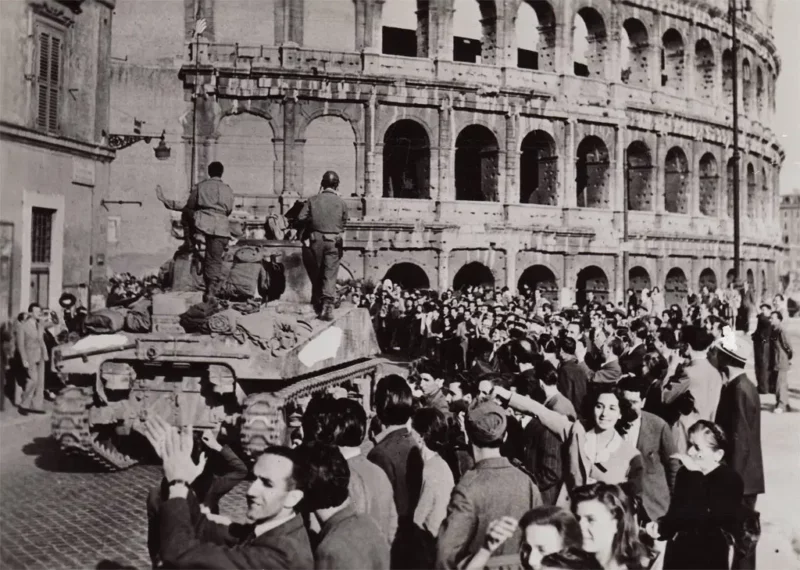
American troops enter Rome in 1944
Credit: barrystrauss.comThere has been a lot of interest in World War II lately with the commemorations of the 80th anniversaries of the liberation of Rome and D-Day in Normandy. So, we would like to share the memories of longtime AMHS member Romeo Sabatini. Many of our members will recall that, for a long time, Romeo was our webmaster and Notiziario editor.
Below are Romeo’s recollections, as a six-year-old, dealing with the Americans coming to Rome in June 1944:
The liberation of Rome. One particularly joyful event was the liberation of Rome by the Allied Forces in 1944. On June 4, the American soldiers entered Rome and paraded through the major downtown streets. I remember it as a sunny, warm day, with people joyously greeting the soldiers, some of them on tanks and jeeps, women hugging them, kissing them, and shouting gloriously. For me, it meant that now I could go freely and fearlessly to the nearby Villa Borghese Park, or walk the length of Via Piemonte to my elementary school, without encountering the ever-present S.S. guards in front of what was the German S.S. Command on Via Piemonte. At that time, I thought that the S.S. on the guards’ helmets stood for the year 44 because It was 1944. There was a real festive atmosphere in Rome that summer of 1944 after the liberation of the city, and it favored us kids who now felt free to roam the streets, to play in the parks, and to deal with the friendly Americans – some of us trying our best to earn a little money, or at least some candy from them.
It was not easy for a family of six like ours to make ends meet during and right after the war, but we made it, thanks to the enterprising spirit and skills we had in our family. My father, who was a policeman before and during the war, lost his job when the Italian police force was disbanded in 1943, but he quickly found temporary jobs as a cook, his craft before joining the police force. He eventually returned to the police force in 1946. My mother, a skilled tailor and embroidery designer, found work at home, finishing dresses for various fashion houses, like Fontana and Schubert. My mother also made all the clothes for herself and the four children, and found the time, in partnership with her younger sister Carolina, to open and manage a stand at Piazza Vittorio, which is a major trade square in Rome, for selling dresses, linens, and other apparel.My older brother Gianni, who was only 12 years old at the end of the war, contrived all sorts of schemes to make a little money, and in many of his endeavors he would take me along. One time Gianni and I were tasked to distribute flyers in the streets of Rome advertising a big show at a Theatre Restaurant, the Casina Delle Rose, in Villa Borghese. We distributed the flyers all over the center of Rome, even near the Fontana di Trevi, but it seemed like we could never finish. So, after a while, we just threw the remaining fliers down the sewers. As compensation, we also were admitted to the Casina delle Rose show. The place was full of people, so our incomplete distribution was sufficient anyway. To this day, I vividly remember the magician’s clever tricks in that show.
In another endeavor in which I was involved, I would accompany my brother Gianni while he illegally sold wine out of his little cart to American soldiers encamped in the Villa Borghese Park. Our parents were not aware of such dealings. We picked up the Marsala wine at a store in Via Sicilia. We then put labels on them and sold the bottles to American soldiers camped on Corso Regina Elena. This profitable business stopped when my brother and I were arrested by American Military Police and Carabinieri. We were loaded on a jeep and driven home where the police searched for contraband liquor in our apartment on Via Umbria. They found nothing. After this incident and a scolding from father, we stopped selling wine. However, upon the suggestion of our mother, Gianni tried instead to sell silk scarfs to American soldiers. Nonno Pietro had constructed a portable wooden tray for Gianni to peddle the scarves. Gianni complained that there was no business with the scarves, so he went on with another business consisting of peddling cigarettes he would somehow get from American soldiers and then sell for a profit to Italians, eager to smoke American cigarettes. I do not remember much about these dealings, except for one transaction involving a large can supposedly filled with American cigarettes. When Gianni opened the tightly sealed can at home, in front of us, it was filled with mud.
Another event involving American soldiers happened in the Villa Borghese Park which was full of tents of encamped American soldiers. As I was walking towards the children’s movie house, appropriately named “Topolino” or Mickey Mouse Theater, I saw American soldiers throwing rocks at a fleeing young man. The kid had tried to steal something from a soldier’s tent, and was now running away for his life. The soldiers’ throws were powerful and fast, just like those of a baseball player. I had never seen so many rocks flying, and so near to my head, but the urchin got away unhurt. Luckily, I was not hit by any rocks.
One last anecdote involved my first experience with the English language. The first few English words that I learned from my uncle Camillo were “please give me chocolate.” My uncle Camillo had come to visit us in Rome. He was now an officer in the newly re-established Italian Army and was wearing his bright new uniform. The story that I heard about him many years later from other members of the family was that, after Italy surrendered in 1943, my uncle joined the partisans to fight against the Germans in Abruzzo. Captured by the Germans, he was able to escape the night before he was scheduled to be shot. Anyway, one day, on my way to the park accompanied by uncle Camillo, I mustered enough courage to approach an American soldier and pronounced the fateful words. The soldier was the first black person I ever saw. I vividly remember the soldier laughing, wide-eyed, throwing up his hands, indicating he had no chocolate, but he did give me a stick of chewing gum, a real novelty at that time.
Many Italian kids at the time decided to learn English, just to have some candy from the soldiers; others even invited soldiers to their homes. One time my brother Gianni brought an American soldier to our home. He must have been an Italian American because he spoke broken Italian to us. We sat him in the kitchen, and he gave us some canned goods and a large round loaf of very white bread wrapped in an American newspaper. Although I could not read English at the time, I became interested in the colored comics of the newspaper used as wrappings for the bread. They were probably from an American Sunday newspaper. Some of the comic characters like Popeye or Donald Duck were new to me. I met them again a few years later in the United States. When I was a teenager, I binged on cartoons shown during the Saturday’s children movie matinees.July/August 2024
-
Magician John Scarne: The Ultimate Card Shark
By Joseph “Sonny” Scafetta, Jr.
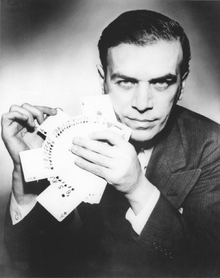
John Scarne
Credit: WikipediaJohn Orlando Carmelo Scarnecchia was born on March 4, 1903, in Steubenville, Ohio. His parents, Fiorangelo and Maria, had emigrated from what was then called the Abruzzi region. When they became U.S. citizens, the family shortened its name to Scarne. They then moved to Fairview, New Jersey. John quit school after the eighth grade and learned from a local card shark how to cheat as a gambler. He also learned about crooked gambling devices, such as marked cards and loaded dice, at a nearby novelty store. However, his Roman Catholic mother dissuaded him from gambling and persuaded him instead to practice magic. John improved his skill at handling cards by learning and devising magical effects with cards. After much practice, he began earning money as a teen magician on the vaudeville circuit.
After World War I ended in November 1918, Scarne befriended Harry Houdini (1874-1926) who taught the teen many tricks. Soon, Scarne had himself tied up with ropes, placed in a bag, and tossed off a bridge into a river. He quickly freed himself. Articles were written about this stunt in many newspapers and magazines. Soon, he was hired as an advisor by many companies to make demonstrations and to teach lessons so that employees learned to detect frauds. Gradually, he became an expert not only at magical effects but also at all kinds of games. When the United States entered World War II on December 8, 1941, he was too old at 38 for the draft. However, he was hired in 1942 as a consultant by the U.S. Army which sent him to bases around the world to teach soldiers how to detect card sharks and dice cheats.
After World War II ended in August 1945, he published Scarne on Dice which was the first of 15 books that he wrote. He also co-authored 13 more books about games. His notoriety soon had him banned from all casinos in Las Vegas, except for the ones owned by Conrad Hilton who hired Scarne to assist him in identifying blackjack card counters and other cheats. The U.S. Senate created a Committee on Gambling and Organized Crime in 1951, and Scarne was called as “the nation’s outstanding gambling authority” to testify about the ways people are cheated. In 1952, Scarne invented Teeko, the first of three board games in which persons with good math skills won. He married Norma Kearney in early 1955 and a son was born to them before the end of the year. Scarne was so proud of becoming a father at 52 and of the success of his first game that he named his son, John Teeko Scarne. The couple had no more children.
Scarne published his autobiography, The Odds Against Me, in 1966. In 1973 Scarne was the technical advisor for the movie The Sting, and doubled for Paul Newman’s hands in scenes involving deck switching and card manipulation. Scarne authored his last book, Scarne’s Guide to Casino Gambling, in 1978. He died in North Bergen, New Jersey, at 82 on July 7, 1985.
Sources: (all accessed March 15, 2024)
LaGumina et al., The Italian-American Experience: An Encyclopedia, at pages 579-580, Garland Publishing, Inc., 2000.
en.wikipedia.org/wiki/John_Scarne
July/August 2024
-
Bussi sul Tirino

By Nancy DeSanti

The church of Santa Maria in Cartiganano in Bussi sul Tirino.
Credit: WikipediaProvince of Pescara, Region of Abruzzo
The beautiful, small town of Bussi sul Tirino is situated in the province of Pescara. It has approximately 2,471 inhabitants, known as Bussesi.
Located on the Tirino river, Bussi lies on the southern boundary of the Gran Sasso-Laga National Park. In the past, agriculture was the main activity in the village due to the abundance of water and fertile soil. At the beginning of the 20th century, the industrialization of Val Pescara fostered the creation of many industries, which are still active in the area.
The original settlement dates to around 1000, during the age of castles. The first mention of Bussi was in 1200, when it was among the areas controlled by the monastery of San Benedetto in Perillis. It was later a fief of the descendants of Berardo da Rajano, the Pignatelli, the Cantelmo, the Pietropaoli, and the Medici families.
The name “Bussi” seems to derive from the name of the boxwood plant, which was very common in the area during the Italic and Roman periods. The Buxio castle, then Bussio, is first mentioned in 1111 as the outer boundary of the territory of the Abbey of San Clemente in Casauria.
However, the history of the municipality dates back even further, to the Lombard era. In fact, outside the town, the Lombard tower of Sutrium still stands today, having served as a fortified outpost used to monitor the valley and enemy movements.
Bussi sul Tirino’s territory offers numerous natural attractions. As mentioned above, the town is bordered by the Tirino river, which originates from the Campo Imperatore water system and winds its way for 25 kilometers through three springs in the Capestrano area. Along its route, the river is fed by other small springs.
The climate is typically mountainous, with cold temperatures in winter and abundant rainfall in spring. During the summer, the town comes to life with events such as the Tirino Festival, which celebrates the river and local traditions.
Today it is known as a canoe spot with some of Europe’s clearest waters upstream to Capestrano.
Now the town is becoming known for its summertime blues and jazz concerts, collectively called “Bussinjazz.” Last year L’Associazione Bussinjazz was formed in memory of Mario Bucci, who has been called the best-known exponent of jazz in Abruzzo.What to See
- Medieval castle
- Remains of the Romanesque church of Santa Maria di Cartignano, with three naves.
Important Dates
- Mid-June – Feasts of San Biagio and Sant’Antonio
- Late July – Feasts of Sant’ Anna and San Pantaleone
- Summer – “Bussinjazz,” blues and jazz music concerts.
Italiano

Tradotto da Ennio Di Tullio
Provincia di Pescara, Regione Abruzzo
La bellissima cittadina di Bussi sul Tirino si trova in provincia di Pescara. Ha circa 2.471 abitanti, detti Bussesi.
Situato sul fiume Tirino, Bussi si trova al confine meridionale del Parco Nazionale del Gran Sasso-Laga. In passato l’agricoltura era l’attività principale del paese perche dell’abbondanza di acqua e di terreno fertile. Agli inizi del XX secolo, l’industrializzazione della Val Pescara favorì la creazione di numerose industrie, tuttora presenti nella zona.
L’insediamento originario risale intorno all’anno Mille, nell’epoca dei castelli. La prima menzione di Bussi risale al 1200, quando era tra i territori controllati dal monastero di San Benedetto in Perillis. Successivamente, fu feudo dei discendenti di Berardo da Rajano, dei Pignatelli, dei Cantelmo, dei Pietropaoli, e dei Medici.
Il nome “Bussi” sembra derivare dal nome della pianta del bosso, molto diffusa nella zona in epoca italica e romana. Il castello di Buxio, poi Bussio, è citato per la prima volta nel 1111 come confine esterno del territorio dell’Abbazia di San Clemente in Casauria.
Pero, la storia del comune risale ancora più lontano, all’epoca longobarda. Fuori dall’abitato, infatti, si trova ancora oggi la torre longobarda di Sutrium, che fungeva da avamposto fortificato utilizzato per monitorare la valle e i movimenti nemici.
Il territorio di Bussi sul Tirino offre numerose attrattive naturali. Come detto sopra, il paese è confinato per il fiume Tirino, che nasce dal sistema idrico di Campo Imperatore e si snoda per 25 chilometri attraverso tre sorgenti nel territorio di Capestrano. Lungo il suo percorso, il fiume è alimentato da altre piccole sorgenti.
Il clima è tipicamente montano, con temperature fredde in inverno e abbondanti precipitazioni in primavera. Durante l’estate, il paese si anima con eventi come il Festival del Tirino, che celebra il fiume e le tradizioni locali.
Oggi è conosciuto come un punto per le canoe con alcune delle acque più limpide d’Europa a monte di Capestrano.
Ora la città sta diventando famosa per i suoi concerti estivi di blues e jazz, collettivamente chiamati “Bussinjazz”. Lo scorso anno è nata L’Associazione Bussinjazz in memoria di Mario Bucci, definito l’esponente più noto del jazz abruzzese.
Attrazioni del luogo:
- Castello medievale
- Resti della chiesa romanica di Santa Maria di Cartignano, a tre navate.
Date da ricordare:
- Metà giugno – Festa di San Biagio e Sant’Antonio
- Fine Luglio – Festa di Sant’Anna e San Pantaleone
- Estate – “Bussinjazz”, concerti di musica blues e jazz.
July/August 2024
-
Siamo Una Famiglia

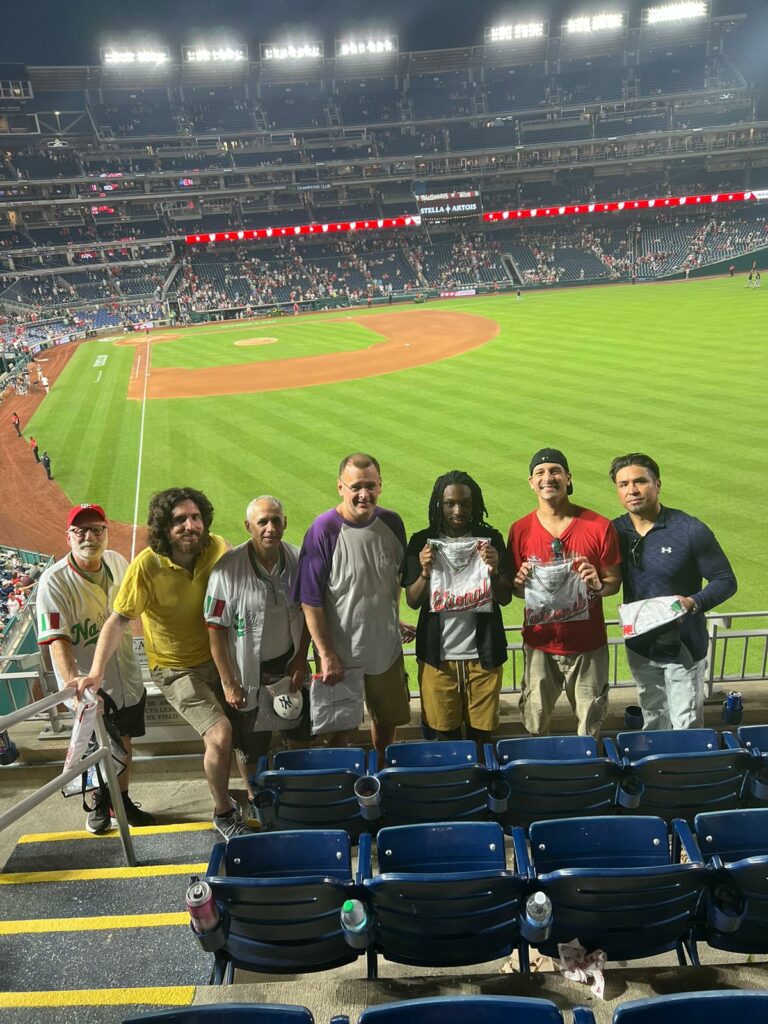
AMHS members and friends enjoyed an evening at Nationals Park for the annual Italian Heritage Night on June 18 to see the Washington Nationals take on the Arizona Diamondbacks (Alas, the Nats lost 5-0). All attendees received a special jersey for the event. Pictured are (left to right) AMHS Treasurer Peter Bell, President Chris Renneker, 2nd VP Rico Allegrino, Tomasso Mazza, Ivan Jones, Ravi Ganesh and Frankie Yupari.
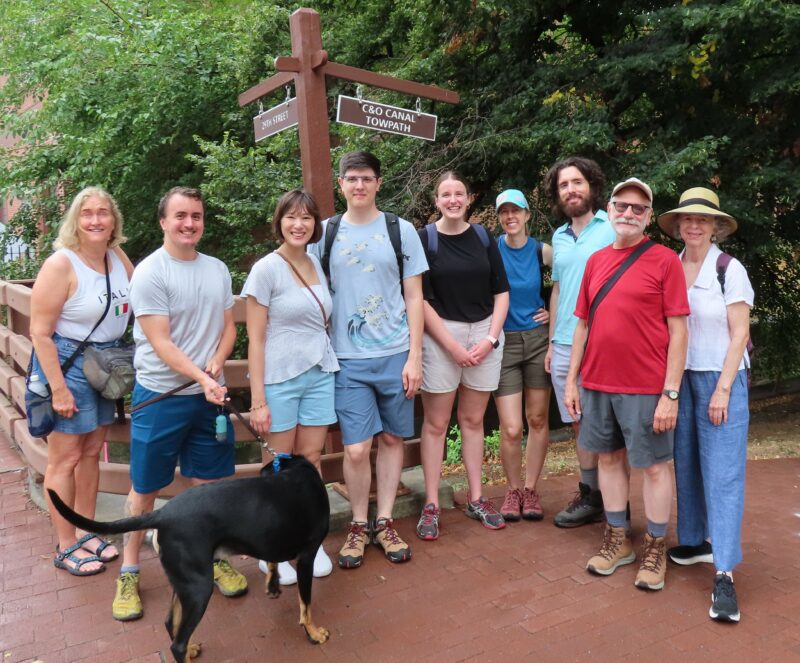
On July 13, AMHS President Chris Renneker, Peter Bell, Barbara Friedman, and Sam Yothers were joined by members of the Office of Textiles and Apparel, U.S. Department of Commerce, all of whom work with Maria D’Andrea-Yothers. The group enjoyed a one-hour walk along the C&O Canal Towpath in Georgetown, followed by an excellent lunch of porchetta sandwiches from Porchetta District. Anyone looking for a great porchetta sandwich in the Washington, DC area – Porchetta District is the place to go (they cater too!). Photo credit: Maria D’Andrea-Yothers
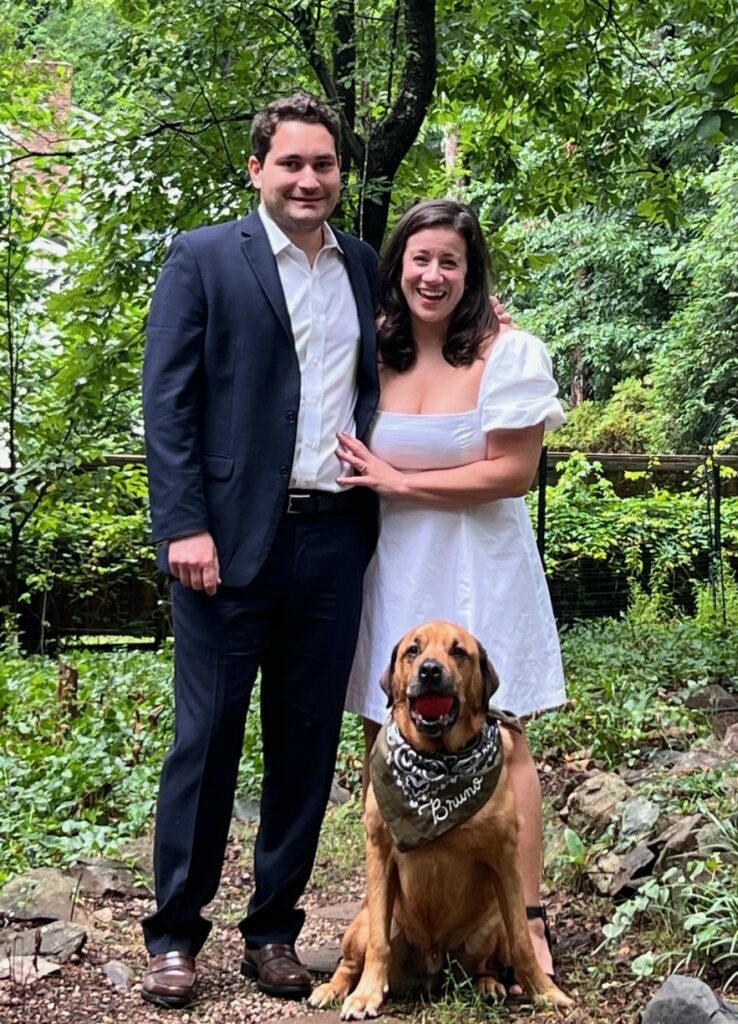
AMHS President Emeritus Lucio D’Andrea and his wife, Edvige, are pleased to announce the marriage of their eldest granddaughter, Angela Pisoni. Angela married Daniel Hopper on July 12, in an intimate ceremony in Charlotte, NC, where the happy couple reside with their dog, Bruno. Congratulations Angela & Daniel, many blessings for a life of love and happiness. Photo credit: Fred Pisoni
July/August 2024
